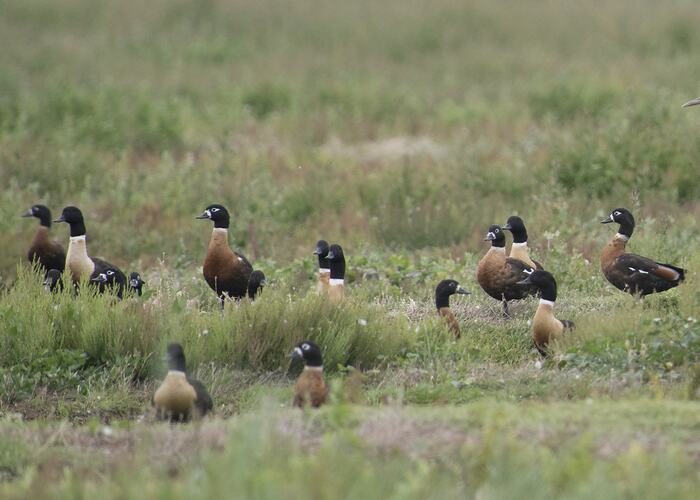General Description
Mainly black with pale grey barring, a white collar and a chestnut breast. Wings have a white shoulder patch, a large, bright green iridescent patch (speculum) and white underneath. Females have a richer coloured breast and a white ring around their eye and base of their bill. Bill to tail length is up to 73 cm.
Biology
Australian Shelducks are generally found near fresh water. They graze in shallow water or on land, and also eat insects, molluscs and algae. They nest in tree hollows, rabbit burrows or holes in cliffs, and they line the nest with down. Breeding pairs are known to stay together each year and males will vigorously defend their breeding territory. Chicks leave the nest after two days, being shown through their territory by their parents. They remain as a family group for six weeks. After the breeding season, shelducks may migrate large distances northwards to wetlands where they gather in large flocks. Here they moult their tail and flight feathers, becoming temporarily flightless.
Distribution
South-eastern and south-western mainland Australia and Tasmania. Vagrant to central Australia. Self-introduced to New Zealand.
Habitat
Wetlands, swamps, lakes, farmlands, pastures and open woodlands.
More Information
-
Animal Type
-
Animal SubType
-
Brief Id
A large, black and chestnut duck with a vivid green wing patch and a distinctive white collar.
-
Maximum Size
73 cm
-
Habitats
-
Diet
Omnivore
-
Endemicity
-
Commercial
No
-
Conservation Statuses
CITES: Not listed, FFG Threatened List: Not listed, EPBC Act 1999: Not listed, IUCN Red List: Least Concern
-
Taxon Name
-
Common Name
Australian Shelduck
-
Kingdom
-
Phylum
-
Subphylum
-
Class
-
Subclass
-
Order
-
Family
-
Subfamily
-
Genus
-
Species Name
tadornoides





